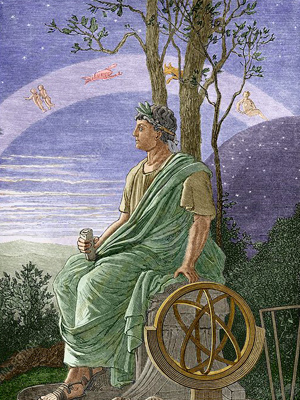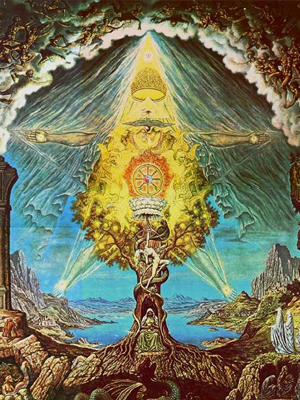Masonic Articles and Essays
Theurgy - Part III
Very Illus..... Bro... Kris Wilson-Slack 33°
Date Published:
2/14/2024
In third part of the series on Masonic Theurgy we learn of the ancient Platonic sequence by which consciousness is transmuted from its mundane existence to the highest reaches of heaven. How can Freemasonry help us to acheive this lofty goal?
 The third aim of Esoteric Freemasonry, as outlined in our first three posts, is that of henosis, or the unity of the human with the divine. To understand henosis, we need to briefly look at the Neoplatonist cosmology. The Spiritual Universe, according to Plotinus, results from a series of emanations from the Source, Divinity:
The third aim of Esoteric Freemasonry, as outlined in our first three posts, is that of henosis, or the unity of the human with the divine. To understand henosis, we need to briefly look at the Neoplatonist cosmology. The Spiritual Universe, according to Plotinus, results from a series of emanations from the Source, Divinity:
- To Hen – The Divine, the Deity without quality;
- Nous – Mind and Universal Consciousness;
- Psyche – The soul of the individual and of the World;
- Physis – Nature, Matter.
In this Neoplatonist Greek cosmology, there was no descent into an underworld as there was no underworld. For them, katabasis was the descent of the soul into a physical body upon incarnation. Hades was allegorized and viewed as the world that we, and all beings, inhabit. Therefore, there was no need to descend to understand divine consciousness. The only way to go was to ascend. Anabasis.
Consequently, to achieve unity with the divine, the human needed to raise himself through the emanations of the divine, anabasis, and theurgy was how this anabasis was and is achieved. The use of theurgy, in the practice of spells, incantations, invocations, and ritual movements was developed primarily by Porphyry, Iamblichus, and Proclus, but these developments were built off the earlier work of Empedocles, Pythagoras, and Plato. Early Neoplatonist works, particularly the Chaldean Oracles, cited the many spiritual beings who traveled within and between these emanations, who lived within each realm. References to these beings have lingered until today albeit in different forms and achieving different purposes: examples are angels, daemons, devas, and elementals. These beings are invoked and requested to help the neophyte on their journey, so they make no missteps or misspeak. They guide the neophyte in the work at his request, and this is done in Freemasonry by the officers and attendees at an initiation ceremony.
Medieval theurgists took the writings from the Neoplatonists and moved them even further towards these spiritual beings becoming active intermediaries for the human toward the Source. With the advent of Christianity, the beings split into those that were for personal gain and those that were for humanity’s gain. Personal gain was considered evil and self-serving whereas those who worked for humanity, or Christianity, were for the betterment of all. Theurgists would summon angels to converse with and seek advice from so that they might receive God’s will. The theurgists would ask for prophecy, or scripture to be explained to them and to understand further the nature of the physical universe so that they may control it. It’s from this time that we see the idea of “magic” being “evil” growing in stature.
Looking at the doctrine of emanation from a Masonic point of view, Freemasonry has continued this tradition and taken back some of the ideas of achieving henosis that originated in antiquity. From the point that the neophyte has, in his initiation, traveled his journeys until he is poised on the threshold of a heavenly world. He has moved from his earthy existence and is within the realms of his “birth,” as a child of heaven. From here, a series of powerful actions take place to bring him through the final portal to the level of the next emanation – in this case, Psyche, the place of the personal and world soul. He is the presence of the beings who work at this level: the officers and columns of Freemasons within the Lodge. Also present are those intermediaries that exist between the realm of Psyche and Physis, attending in a “temple not made with hands, eternal in the heavens.” He has achieved this anabasis through all of their theurgic efforts. One thing many neophytes experience during this time in the ceremony is the sense that the “room is full of people,” that there are many more beings in attendance than actually are. Couldn't this portal, constructed within the center of the temple and opened by Divine, ritual magic be the reason for this feeling?
 There are many, many more aspects to the Masonic ritual that could be considered theurgic and much more to explore throughout the degrees of Freemasonry. The Neoplatonist philosophy, which informs so much of Freemasonry, should not be considered only a mental pursuit. We derive much of the active principles of Freemasonry in these Neoplatonic works, and delving into these origins enrichens our ritual a hundredfold. In fact, to fully achieve the initiatory anabasis, every M.M. must consider themselves a theurgist.
There are many, many more aspects to the Masonic ritual that could be considered theurgic and much more to explore throughout the degrees of Freemasonry. The Neoplatonist philosophy, which informs so much of Freemasonry, should not be considered only a mental pursuit. We derive much of the active principles of Freemasonry in these Neoplatonic works, and delving into these origins enrichens our ritual a hundredfold. In fact, to fully achieve the initiatory anabasis, every M.M. must consider themselves a theurgist.
This is not to say that Freemasons should learn spell casting or create their own invocations, especially in the modern, uneducated, and profane sense of “theurgy.” The theurgy aspects of the ritual are already deeply embedded in all that we do before, during, and after a Lodge meeting. The theurgist is a practitioner of divine magic, not a practitioner of magic in the world of appearances. We are educated by employing charges, writings, and study to just begin to understand what is necessary for the improvement of all humanity. Active participation in Freemasonry educates the neophyte in what is necessary to journey from the practical aim of awakening our underdeveloped capabilities towards, I believe, henosis, the goal of Esoteric Freemasons for all of humanity.
More Masonic Articles
Explore articles and essays written by Freemasons about Freemasonry.
Read More
Membership
Interested in becoming a member of the worlds oldest Fraternal organization?
Read More